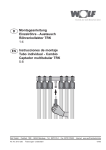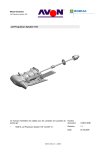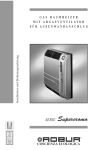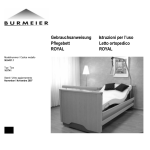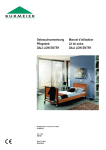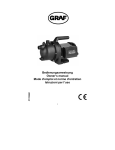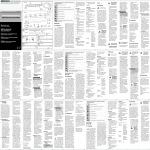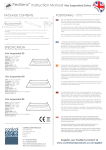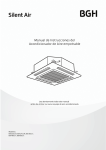Download TRK Montageanleitung Einzelröhre
Transcript
TRK Technik, die dem Menschen dient. D Montageanleitung Einzelröhre - Austausch Röhrenkollektor TRK 1-4 ES Instrucciones de montaje Tubo individual - Cambio Captador multitubular TRK 5-8 GB Installation Instructions Replacing individual tubes Tube collector TRK 9-12 IT Istruzioni per il montaggio Sostituzione del singolo tubo Collettore a tubi sottovuoto TRK 12-16 Wolf GmbH · Postfach 1380 · 84048 Mainburg · Tel. 08751/74-0 · Fax 08751/741600 · Internet: www.wolf-heiztechnik.de 3061285_1206 Art.-Nr. 30 61 285 Änderungen vorbehalten! 12/06 1 Servicehinweise Defekte Röhren austauschen TRK Sicherheitshinweise WARNUNG, STURZGEFAHR: Bei der Arbeit auf dem Dach sowie beim Hinauf- und Hinabsteigen besteht Sturzgefahr. Beachten Sie unbedingt die Unfallverhütungsvorschriften und verwenden Sie geeignete Absturzsicherungen. WARNUNG, VERLETZUNGSGEFAHR: Bei der Arbeit auf dem Dach besteht die Gefahr, dass Werkzeuge, Kollektorteile oder Glassplitter vom Dach fallen und Personen verletzen, die sich darunter aufhalten. Sperren Sie den Gefahrenbereich am Boden vor Beginn der Arbeit ab und warnen Sie Personen, die sich in der Nähe oder im Gebäude aufhalten. Sorgen Sie dafür, dass Kinder fern gehalten werden. Unbefugte Personen dürfen nicht auf das Dach steigen. Sammeln Sie, falls vorhanden, Glassplitter ein und lassen Sie sie nicht vom Dach fallen. WARNUNG, VERLETZUNGSGEFAHR: Gefahr von Schnitt- und Augenverletzungen durch Glassplitter beim Entfernen beschädigter und dem Einsetzen neuer Röhren. Tragen Sie bei diesen Arbeiten Schutzhandschuhe und Schutzbrille. VORSICHT, VERBRENNUNGSGEFAHR: Wenn der Kollektor vor dem Röhrenaustausch direkter Sonneneinstrahlung ausgesetzt war, kann er sehr heiß sein. Verbrennungsgefahr beim Berühren! Führen Sie den Austausch nur an einem bewölkten Tag und nicht während der Mittagszeit aus oder decken sie den Kollektor mindestens eine Stunde vorher mit einer Decke ab, damit er abkühlen kann. Wer darf Röhren austauschen? Der Austausch defekter Kollektorröhren darf nur von Personen ausgeführt werden, die aufgrund ihrer beruflichen Qualifikation mit der Installation und sicheren Ausführung vertraut sind (Fachhandwerker). Der Röhrenaustausch muss von zwei Personen ausgeführt werden. Zugelassene Ersatzröhren Verwenden Sie ausschließlich TRK-Original-Ersatzröhren von WOLF. Versuchen Sie nicht, beschädigte Röhren zu reparieren, und verwenden Sie keine anderen als Original-Ersatzröhren von WOLF. Nichtbeachtung kann zur Beschädigung der Anlage führen und gefährdet den Gewährleistungsanspruch. Benötigtes Werkzeug Zum Austausch von Kollektorröhren benötigen Sie ein weiches, sauberes Tuch, einen Schraubenzieher und jeweils einen Innen-Sechskantschlüssel SW 4 und SW 6. Anlage drucklos schalten Vor dem Austausch defekter Röhren muss der Solarkreis drucklos geschaltet werden. Gehen Sie dazu nach der Anleitung des Systems vor. Die Anlage muss ausgeschaltet und gegen Wiedereinschalten gesichert werden. Sie muss auch elektrisch außer Betrieb genommen werden und darf erst wider in Betrieb gesetzt werden, wenn der Röhrenaustausch wie beschrieben abgeschlossen und eine neue Röhre eingesetzt ist. Defekte Röhre entfernen Packen Sie die Ersatzröhre aus, bevor Sie auf das Dach steigen, und nehmen Sie die Röhre, alle mitgelieferten Teile, das mitgelieferte Fett sowie ein weiches Tuch (nicht im Lieferumfang enthalten) mit auf das Dach. Lösen Sie am defekten Kollektor zunächst mit einem Innen-Sechskantschlüssel SW 4 die beiden Schrauben unten an der Z-Schiene, ohne sie aber ganz herauszudrehen. Schieben Sie das dahinter liegende Halteblech, das die Kollektorröhren hält, zum Dach hin weg, so dass die Röhren unten nicht mehr festgehalten werden. 2 3061285_1206 TRK Entfernen Sie dann mit einem Schraubenzieher die 4 Schrauben der Abdeckung oben am Kollektor und nehmen Sie die Abdeckung mit Dämmung ab. Legen Sie sie so zur Seite, dass sie nicht hinabfallen kann. Wenn die defekte Röhre in unmittelbarer Nachbarschaft einer der Befestigungsschrauben M8 liegt, so lösen Sie die Schraube mit einem Innen-Sechskantschlüssel SW 6, da sonst die Röhre nicht entnommen werden kann. Drehen Sie die Schraube aber nicht heraus. Wenn die defekte Röhre selbst angeschraubt ist, drehen Sie die Schraube ganz heraus und entnehmen Sie sie. Drehen Sie aber niemals beide Schrauben heraus, da sonst der Kollektor nicht mehr gehalten wird! Halten Sie nun die defekte Röhre mit einer Hand an der Kunststoffkappe fest und schieben Sie mit der anderen Hand den Kunststoffschieber zur Seite, der die Röhre am Sammler festhält. Nehmen Sie den Schieber vom Sammler ab. WARNUNG, VERLETZUNGSGEFAHR Da die Röhre nun nicht mehr vom Kollektor gehalten wird, könnte sie aufgrund der Neigung nach unten aus dem Kollektor gleiten und vom Dach fallen. Verletzungsgefahr für unten stehende Personen! Die Röhre muss deshalb bei der nun folgenden Entnahme von der zweiten Person festgehalten werden. Drücken sie die Röhre mit beiden Händen vom Sammler. Verwenden Sie keinesfalls Werkzeug, da sonst der Sammler beschädig werden könnte. O-Ringe austauschen Entfernen Sie mit der Hand oder dem Tuch vorsichtig die beiden O-Ringe am Sammleranschluss, an dem die Röhren aufgesteckt war. Achten Sie darauf, dass die Dichtflächen nicht beschädigt werden. Reinigen Sie den Sammleranschluss mit dem Tuch. Schieben Sie die beiden neuen O-Ringe auf: zunächst den schwarz-gelben, dann den schwarzen. Fetten Sie den Anschluss und die O-Ringe mit dem mitgelieferten Fett ein. Verwenden Sie dazu ausschließlich das mitgelieferte Fett. Verwenden Sie keinesfalls mineralisches Fett und gehen sie unbedingt in der beschriebenen Reihenfolge vor! 3061285_1206 3 TRK Neue Kollektorröhre einsetzen Nehmen Sie nun die neue Röhre zur Hand. Stecken Sie das Koaxialrohr in den Sammleranschluss und schieben Sie das Rohr anschließend auf den Sammler. Achten Sie darauf, dass die Kunststoffteile sauber in den Nuten und Federn der angrenzenden Teile laufen. Schieben Sie die Röhre oben und unten gleichzeitig auf die Kollektorhalterungen. Achten Sie darauf, dass die Röhre nicht aus der Kollektorebene herausgehoben wird. Bruchgefahr! Sichern sie das Rohr oben am Sammler, indem Sie den mitgelieferten Kunststoffschieber einschieben. Wenn sie eine der beiden Schrauben M8 gelöst haben, drehen Sie sie wieder ein. Setzen Sie die Abdeckung mit Dämmung wieder auf und schrauben Sie sie fest. Schieben Sie am Fußende das Halteblech hinter der Befestigungsschiene wieder zu den Röhren hin, so dass sie gehalten werden, und drehen Sie die beiden Schrauben unten an der Befestigungsschiene wieder fest. Anlage wieder in Betrieb nehmen Beachten und befolgen Sie bei der Wiederinbetriebnahme die Montageanleitung des Gesamtsystems. Vor der Wiederinbetriebnahme muss eine Dichtigkeitsprüfung vorgenommen und müssen Kollektor und Solarkreis vollständig entlüftet werden. Handfüllpumpen sind dazu nicht geeignet, eine Jetpumpe (min. 800 W, 40 m Förderhöhe) ist erforderlich. Der Fülldruck soll dabei 0,5 bar über dem Druck im Ausgleichsgefäß liegen. Die Pumpe sollte zur Vorentlüftung mindestens 30 Minuten laufen und mehrmals ein- und ausgeschaltet werden. Dabei sollte der Wärmeträger über einen Kessel-, Füll- und Entleerhahn (KFE-Hahn), eingebaut im Rücklauf zwischen Wärmetauscher und Umwälzpumpe, in einen Behälter laufen und von dort wieder mit der Jetpumpe ins System zurückgedrückt werden. Die Anlage ist dann gut entlüftet, wenn längere Zeit keine Blasen im rücklaufenden Wärmeträger sichtbar sind. Der Kollektor kann nun, wenn er luftfrei ist, wieder in Betrieb genommen werden. Er muss ggf. nach einigen Tagen nochmals entlüftet werden. 4 3061285_1206 TRK Technik, die dem Menschen dient. Instrucciones de montaje Tubo individual - Cambio Captador multitubular TRK Wolf GmbH · Postfach 1380 · 84048 Mainburg · Tel. 08751/74-0 · Fax 08751/741600 · Internet: www.wolf-heiztechnik.de 3061285_1206 Con reserva de modificaciones. FR5 Instrucciones de servicio Cambiar tubos defectuosos TRK Advertencias de seguridad ADVERTENCIA, PELIGRO DE CAÍDA: Cuando se trabaja en el tejado, y al subir y bajar del mismo, existe peligro de caída. Respétese a rajatabla la normativa de prevención de accidentes y utilícense seguros contra caídas adecuados. ADVERTENCIA, PELIGRO DE LESIONES: Cuando se trabaja en el tejado, existe peligro de que caigan herramientas, partes del captador o esquirlas de vidrio y causen lesiones a personas situadas debajo. Acote la zona de peligro en el suelo antes de comenzar los trabajos y advierta a las personas que permanecen en los alrededores o dentro del edificio. Asegúrese de mantener alejados a los niños. Las personas no autorizadas no deben subir al tejado. Recoja las esquirlas de vidrio que puedan existir, evitando que caigan del tejado. ADVERTENCIA, PELIGRO DE LESIONES: Peligro de corte y de lesiones oculares por esquirlas de vidrio al desmontar tubos dañados y montar tubos nuevos. Lleve guantes de protección y gafas de protección durante los trabajos. PRECAUCIÓN, PELIGRO DE QUEMADURAS: El captador puede estar muy caliente si ha estado expuesto a la luz solar directa antes de cambiar los tubos. ¡Peligro de quemaduras por contacto! Realice el cambio sólo en días nublados, evitando las horas del mediodía, o cubra el captador con una manta por lo menos una hora antes, para que pueda enfriarse. ¿Quién debe cambiar los tubos? El cambio de los tubos de captador defectuosos se confiará exclusivamente a profesionales cualificados que estén familiarizados con la instalación y ejecución segura (instaladores especializados). Para cambiar los tubos se requieren dos personas. Tubos de recambio autorizados Se utilizarán exclusivamente tubos de recambio originales TRK de WOLF. No intente reparar tubos dañados y no utilice tubos que no sean recambios originales de WOLF. La inobservancia de lo señalado puede causar daños a la instalación e invalidar la garantía. Herramientas necesarias Para cambiar los tubos del captador se necesita un paño suave limpio, un destornillador y llaves Allen EC 4 y EC 6. Despresurizar la instalación Antes de cambiar los tubos averiados hay que quitar la presión del circuito solar. Procédase según se especifica en las instrucciones del sistema. La instalación ha de desconectarse y asegurarse contra toda nueva puesta en marcha. Además deberá desconectarse también la parte eléctrica de la instalación, que no se pondrá en marcha nuevamente hasta que se hayan cambiado los tubos y se haya instalado un tubo nuevo. Desmontar tubos defectuosos Desembale el tubo de recambio antes de subir al tejado y lleve consigo el tubo, las piezas suministradas, la grasa incluida y un paño suave (no incluido en el volumen de suministro). Con la llave Allen EC 4, afloje los dos tornillos del carril Z inferior del captador averiado, sin desenroscarlos del todo. Empuje la chapa de sujeción trasera, que soporta los tubos del captador, hacia el tejado para liberar la parte inferior de los tubos. 6 3061285_1206 TRK Con un destornillador, desenrosque los 4 tornillos de la cubierta en la parte superior del captador y quite la cubierta junto con el aislamiento. Colóquelos a un lado de forma que no puedan caer hacia abajo. Si el tubo defectuoso está situado junto a uno de los tornillos de fijación M8, hay que aflojar el tornillo con una llave Allen EC 6 para poder desmontar el tubo. Atención: no lo desenrosque completamente. Si es el tubo defectuoso el que está atornillado, desenrosque completamente el tornillo y sáquelo. No obstante, nunca deben desenroscarse completamente los dos tornillos porque se soltaría el captador. Con una mano, sujete el tubo defectuoso por el capuchón de plástico y, con la otra, empuje a un lado la corredera de plástico que sujeta el tubo al colector. Desmonte la corredera del colector. ADVERTENCIA, PELIGRO DE LESIONES Puesto que el captador ya no lo sujeta, el tubo podría deslizarse hacia abajo debido a la inclinación y caer del tejado. Peligro de lesiones para las personas situadas debajo. Por tanto, para poder sacarlo, es preciso que otra persona sujete el tubo. Saque el tubo con ambas manos del colector. No utilice herramientas, pues podrían dañar el colector. Cambiar juntas tóricas Con la mano o con el paño, quite con cuidado las dos juntas tóricas de la conexión del colector en la que estaba encajado el tubo. Atención a no dañar las superficies de hermetización. Limpie la conexión del colector con un paño. Coloque las dos juntas tóricas nuevas: primero la de color amarillo/negro y después la negra. Engrase la conexión y las juntas con la grasa suministrada. Utilice exclusivamente la grasa suministrada. No utilice en ningún caso grasa mineral y respete al pie de la letra el orden descrito. 3061285_1206 7 TRK Introducir el tubo de captador nuevo Sujete el tubo nuevo. Introduzca el tubo coaxial en la conexión del colector e introduzca después el tubo en el colector. Asegúrese de que las piezas de plástico encajan perfectamente en las ranuras y los resortes de los elementos vecinos. Introduzca la parte superior e inferior del tubo al mismo tiempo en los soportes del captador. Atención a que el tubo no salte del plano del captador. ¡Peligro de rotura! Asegure la parte superior del tubo en el colector introduciendo la corredera de plástico suministrada. Si ha aflojado alguno de los tornillos M8, apriételo nuevamente. Monte la cubierta junto con el aislamiento y atorníllela. Empuje la chapa de sujeción de la parte inferior, situada detrás del carril de fijación, hacia los tubos para que éstos queden sujetos y apriete nuevamente los dos tornillos situados en el lado inferior del carril. Poner en marcha nuevamente la instalación Para la nueva puesta en marcha, respete lo especificado en las instrucciones de montaje del sistema. Antes de la nueva puesta en marcha es preciso comprobar la estanquidad y purgar completamente el captador y el circuito solar. Las bombas de llenado manual no son adecuadas; se precisa una bomba de chorro (mín. 800 W, 40 m de altura de bombeo). La presión de llenado debería ser 0,5 bar mayor que la presión del vaso de compensación. Para la purga inicial, la bomba debería funcionar por lo menos durante 30 minutos y conectarse y desconectarse varias veces. El termofluido debería fluir a un depósito a través de una llave de llenado y vaciado de la caldera (llave KFE), instalada en el retorno, entre el intercambiador de calor y la bomba de circulación, y retornar al sistema impelido por la bomba de chorro. La instalación se habrá purgado correctamente si, durante un tiempo suficiente, no se observan burbujas en el termofluido que retorna. Si está libre de aire, el captador puede ponerse nuevamente en marcha. Eventualmente habrá que volver a purgarlo pasados unos días. 8 3061285_1206 TRK Technik, die dem Menschen dient. Installation Instructions Replacing individual tubes Tube collector TRK Wolf GmbH · Postfach 1380 · 84048 Mainburg · Tel. 08751/74-0 · Fax 08751/741600 · Internet: www.wolf-heiztechnik.de 3061285_1206 Subject to technical modifications. GB9 Safety instructions Removing faulty tubes TRK Safety instructions WARNING, RISK OF A FALL: There is a risk of a fall during work on the roof and whilst ascending/descending the roof. Always observe all applicable accident prevention regulations and use suitable methods for preventing a fall. WARNING, RISK OF INJURY: During the installation on the roof there is a risk that tools, collector parts or glass splinters fall from the roof and injure people below. Seal off the danger area on the ground prior to commencing your work and warn people that may be near or inside the building. Ensure that children are kept away. Unauthorised individuals must not ascend the roof. Collect, where required, all glass splinters and never let them fall from the roof. WARNING, RISK OF INJURY: Risk of cuts and eye injuries through glass splinters during the removal of damaged tubes and during their replacement. Always wear protective gloves and goggles during this kind of operation. CAUTION, RISK OF BURNING: Collectors can be very hot if they were exposed to direct solar irradiation prior to the tube replacement. There is a risk of burning when touching the collector. Only carry out the replacement when it is overcast/cloudy and never during midday; alternatively cover the collector with a blanket for at least one hour to allow it to cool down. Who should replace the tubes? Only individuals who are familiar with the installation and safe implementation (contractor) on account of their vocational/professional qualification. Two people are needed to replace the tubes. Approved replacement tubes Only use original TRK replacement tubes from WOLF. Never attempt to repair faulty tubes and never use tubes other than original replacement tubes from WOLF. Non-observation can result in system damage that puts the manufacturer’s warranty at risk. Required tools The replacement of the collector tubes requires a soft clean cloth, a screwdriver and respectively SW 4 and SW 6 Allen keys. Put your system into an unpressurised state Prior to replacing faulty tubes, the pressure in the solar circuit needs to be neutralised. For this, proceed in accordance with the system instructions. Disconnect the system from its power supply and prevent unauthorised reconnection. Decommission the system electrically and only return it into use once the tube replacement has been completed as described. Removing the faulty tube Unpack the replacement tube before climbing onto the roof and take the tube, all components supplied with it and the grease supplied as well as a soft cloth (not part of the standard delivery) with you onto the roof. Initially, release both screws at the faulty collector at the bottom of the Z rail using a SW4 Allen key, without fully removing the screws. Push the retaining plate below that secures the collector tube, towards the roof so that the bottom of the tube is no longer held in place. 10 3061285_1206 TRK Then, remove the four screws from the cover at the top of the collector with a screwdriver, and remove the cover with its insulation. Put it aside so it cannot fall. If the faulty tube is immediately adjacent to a M8 fixing screw, undo the screw with a SW6 Allen key, otherwise you cannot remove the tube. However, do not fully remove the screw. Fully remove the screw if the faulty tube itself is secured by it. However, never fully undo both screws, otherwise the tube would no longer be held! Now hold the faulty tube with one hand at the plastic cap and, with your free hand, push the plastic slider aside that retains the tube at the header. Remove the slider from the header. WARNING, RISK OF INJURY As the tube is no longer held by the collector, the slope of the roof could lead to it sliding down out of the collector and falling off the roof. This represents a risk for anyone below. Therefore, the tube must be held by the second person during the following removal. Push the tube with both hands off the header. Never use tools, otherwise the header could be damaged. Replacing the O-rings Carefully by hand or with the cloth, remove both O-rings from the header connection, where the tubes were plugged in. Ensure that the sealing faces are not damaged. Clean the header connection with the cloth. Push on both new O-rings: first the blackyellow one, then the black one. Lubricate the connection and both O-rings with the grease supplied. Only use the grease supplied. Under no circumstances use mineral-based grease and never deviate from the sequence described here. 3061285_1206 11 TRK Inserting the replacement tube Now take up the new tube. Push the coaxial pipe into the header connection and push the tube onto the header. Ensure that the plastic pieces run properly in the tongue and groove of the adjacent parts. Push the tube simultaneously at the top and bottom onto the collector retainers. Ensure that the tube is not lifted out of the collector level. Risk of breakage. Secure the tube at the top of the header by pushing the plastic slider supplied inwards. If you have undone one of the M8 screws, retighten it now. Replace the cover with insulation and secure it with the screws previously removed. At the foot end, push the retaining plate behind the fixing rail towards the tubes again so they are held in place; then retighten both screws at the bottom fixing rail. Restarting the system Observe the installation instruction for the system as a whole when taking the system into use again. Carry out a leak test before taking the system back into use, and completely ventilate the collector and solar circuit. Manual fill pumps are unsuitable for this purpose; this task requires a jet pump (at least 800 W, 40 m head). The fill pressure should be 0.5 bar higher than the expansion vessel inlet pressure. Run the pump on pre-purge for at least 30 minutes and start/stop it several times. For this, the heat transfer medium must flow through a fill & drain valve, fitted into the return between the heat exchanger and the circulation pump into a container and from there back into the system, propelled by the jet pump. The system is properly ventilated when no more bubbles appear in the returning medium for a longer period of time. The collector can now be taken into use again, subject to being free of airlocks. If required, it may need to be ventilated again after a few days. 12 3061285_1206 TRK Technik, die dem Menschen dient. Istruzioni per il montaggio Sostituzione del singolo tubo Collettore a tubi sottovuoto TRK Wolf GmbH · Postfach 1380 · 84048 Mainburg · Tel. 08751/74-0 · Fax 08751/741600 · Internet: www.wolf-heiztechnik.de Wolf Italia S.r.l. · Via 25 Aprile, 17 · 20097 S. Donato Milanese (MI) · Tel. 02-5161641 · Fax 02-515216 · Internet: www.wolfitalia.com 3061285_1206 Subject to technical modifications. IT13 Avvertenze per l‘assistenza tecnica Sostituzione dei tubi difettosi TRK Avvertenze per la sicurezza ATTENZIONE, PERICOLO CADUTE: Durante i lavori sul tetto come anche durante la salita e la discesa esiste il pericolo di cadute. Attenersi scrupulosamente alle prescrizioni per evitare incidenti ed utilizzare delle protezioni adattate con eventuali cadute. ATTENZIONE, PERICOLO DI FERITE: Durante i lavori sul tetto esiste il pericolo di caduta degli attrezzi, del materiale di montaggio, dei collettori oppure delle scheggie di vetro, ferendo in questo modo le persone che si trovano in basso. Chiudere la zona di pericolo prima di iniziare i lavori ed avvertire le persone che si trovano nelle vicinanze oppure in casa. Tenere lontano i bambini. Persone non autorizzate non devono salire sul tetto. Raccogliere se necessario eventuali scheggie di vetro e non fare cadere nulla dal tetto. ATTENZIONE, PERICOLO DI FERITE: Pericolo di ferite di taglio oppure degli occhi per scheggie di vetro durante la sostituzione di nuovi tubi. Durante questi lavori portare sempre dei guanti protettivi e degli occhiali di protezione. ATTENZIONE, PERICOLO DI SCOTTATURE: Con l‘irraggiamento solare diretto il collettore può raggiungere temperature molto alte. Esiste il pericolo di scottature in caso di contatto! Eseguire il montaggio sul tetto solo in una giornata nuvolosa e non durante le ore più calde oppure coprire il collettore con una coperta. Chi è autorizzato ad eseguire il montaggio dei collettori? La progettazione del montaggio, il montaggio sul tetto e la messa in funzione del collettore a tubi sottovuoto deve essere eseguita solo da persone in possesso dei requisiti tecnici per quanto riguarda l‘installazione e l‘esecuzione dell‘impianto a regola d‘arte ed in modo sicuro (tecnico specializzato ed autorizzato). Per effettuare il montaggio sul tetto sono necessarie due persone. Tubi di sostituzione idonei Utilizzare esclusivamente tubi TRK originali WOLF per la sostituzione. Non cercare di riparare dei tubi difettosi ed utilizzare sempre tubi originali WOLF. La innosservanza di quanto sopra può portare a danneggiamenti sull‘impianto ed influisce sulla garanzia. Attrezzi/materiali necessari Per la sostituzione dei tubi collettori sono necessari un panno morbido, pulito, un cacciavite e sempre una chiave esagonale SW 4 e SW 6. Togliere la pressione dell‘impianto Prima della sostituzione dei tubi difettosi, togliere la pressione dal circuito solare procedendo in base alle istruzioni del sistema. L‘impianto deve essere spento e deve essere assicurato contro una eventuale riaccensione. Deve essere messa fuori funzione anche la parte elettrica e può essere rimessa in servizio dopo aver terminato la sostituzione dei tubi come descritto e dopo aver inserito il tubo nuovo. Togliere il tubo difettoso Prima di salire sul tetto, togliere il tubo di sostituzione dal suo imballo e portare sul tetto il tubo stesso, tutti i pezzi ed il grasso forniti ed un panno morbido (non in dotazione). Allentare inizialmente le due viti sul binario inferiore del collettore difettoso utilizzando una chiave esagonale SW 4 senza svitarle completamente. Spingere la lamiera di sostegno posizionata sul retro, che serve come supporto dei tubi collettore, verso il tetto, in modo che i tubi non possano più essere tenuti in basso. 14 3061285_1206 TRK Svitare le 4 viti dalla parte alta del collettore e togliere la copertura con l‘isolamento. Posizionarla in parte in modo che non possa cadere. Se il tubo difettoso si trova nelle immediate vicinanze di una delle viti di fissaggio M8, svitare la vite con un cacciavite esagonale SW 6, altrimenti il tubo non può essere estratto. Non svitare la vite completamente. Se lo stesso tubo difettoso è avvitato, svitare completamente la vite ed estrarla. Non svitare mai entrambe le viti, in questo modo il collettore è libero! Tenere il tubo difettoso con una mano sul raccordo in plastica e spingere lateralmente il pezzo scorrevole in plastica che fissa il tubo al collettore. Togliere il pezzo scorrevole dal collettore. ATTENZIONE, PERICOLO DI FERITE Il tubo in questo momento non viene più tenuto dal collettore e potrebbe per causa della pendenza scivolare verso la parte inferiore del collettore e cadere dal tetto. Pericolo di ferite per le persone sottostanti! Il tubo deve essere quindi tenuto da una seconda persona durante la seguente estrazione. Con entrambe le mani premere il tubo fuori dal collettore. Non utilizzare in nessun caso degli attrezzi per evitare il danneggiamento del collettore. Sostituzione degli O-Ring In modo cauto, togliere i due O-Ring dall‘attacco collettore sul quale erano inseriti i tubi utilizzando le mani oppure un panno facendo attenzione di non danneggiare le superfici di tenuta. Pulire l‘attacco del collettore con il panno. Spingere i due nuovi O-Ring, iniziando con quello nero-giallo e di seguito quello nero. Ingrassare l‘attacco e gli O-Ring con il grasso fornito. Utilizzare esclusivamento il grasso in dotazione. Non utilizzare in nessun caso del grasso minerale e procedere assolutamente nell‘ordine descritto in queste istruzioni! 3061285_1206 15 TRK Inserimento del nuovo tubo sul collettore Prendere il mano il nuovo tubo. Inserire il tubo coassiale nell‘attacco collettore e spingere facendo attenzione ad inserire in modo corretto le parti in plastica nelle scanalature e linguette delle parti adiacenti. Inserire il tubo contemporaneamente nei supporti superiore ed inferiore del collettore, facendo attenzione che il tubo non fuoriesca dal piano del collettore. Pericolo di rottura ! Assicurare il tubo sulla parte superiore del collettore inserendo il pezzo scorrevole in plastica fornito. Se è stata svitata in precedenza una delle due viti M8, riavvitarla. Riappoggiare la copertura con l‘isolamento ed avvitarla. Spingere la lamiera di sostegno sulla parte terminale dietro il binario di fissaggio nuovamente verso i tubi in modo che sia a tenuta ed avvitare le due viti sulla parte inferiore del binario di fissaggio. Rimessa in funzione dell‘impianto Per la rimessa in funzione dell‘impianto, seguire attentamente le istruzioni di montaggio dell‘intero sistema. Prima della messa in funzione deve essere eseguita una prova di tenuta e devono essere disaerati completamente i collettori ed il circuito solare. Non sono adatte delle pompe a carica manuale. Deve essere utilizzata una pompa Jet (min. 800 W, prevalenza 40 m). La pressione di carica deve essere superiore di 0,5 bar rispetto alla pressione di precarica del vaso di espansione. La pompa dovrebbe funzionare almeno 30 minuti per consentire una pre-disaerazione e deve essere spenta e riaccesa più volte. In questa fase il fluido termoconduttore dovrebbe fluire in un contenitore attraverso un rubinetto di scarico, inserito nel ritorno tra lo scambiatore di calore e la pompa di ricircolo, e da lì caricato nuovamente nel sistema attraverso la pompa Jet. L‘impianto è stato disaerato perfettamente se non sono visibili delle bolle nel liquido termoconduttore per un periodo prolungato. 16 3061285_1206
















